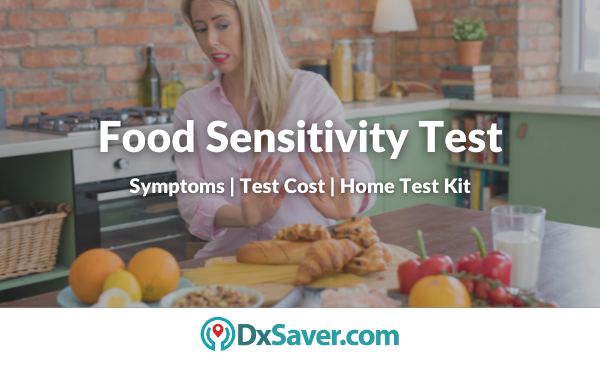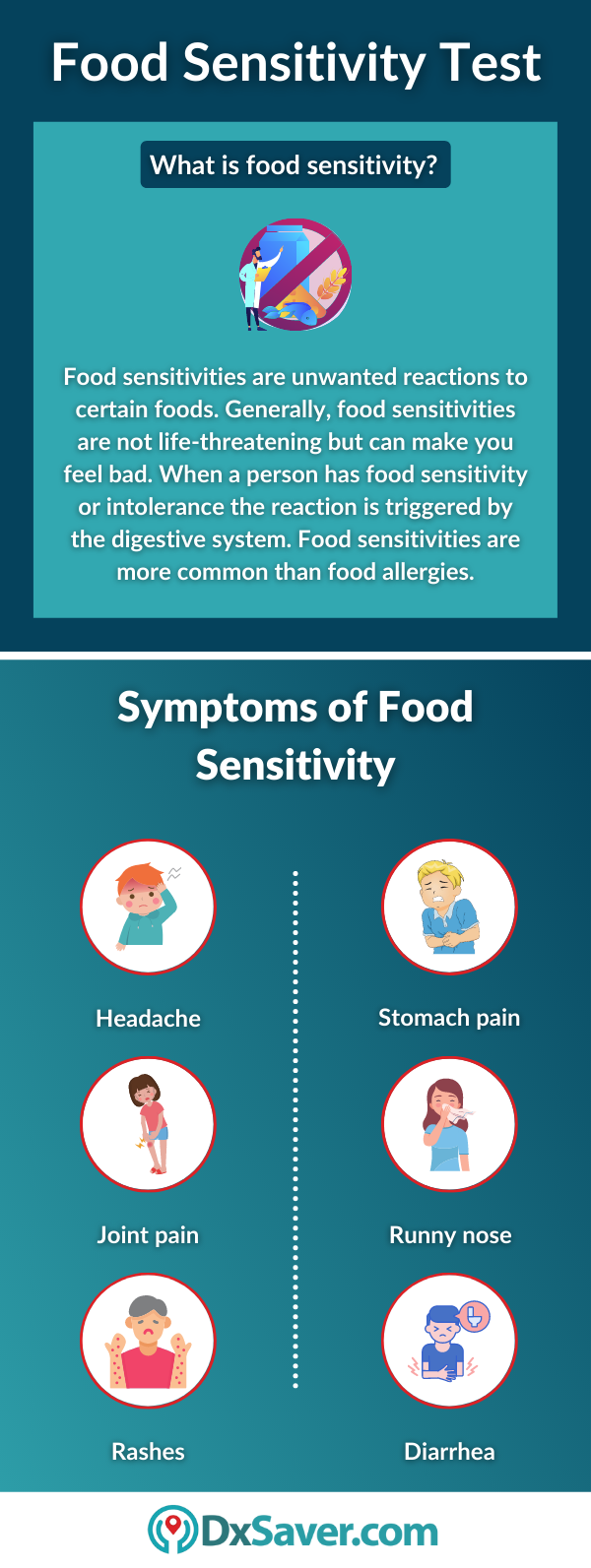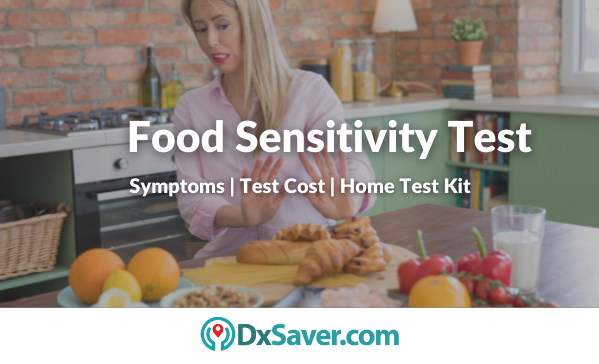
Occasionally, certain foods can make you feel unwell, regardless of whether they are healthy or not. It is tricky to figure out which foods are the culprits because food sensitivity reactions are often delayed by a few hours or longer after eating the foods. To identify problematic foods, health practitioners may recommend a food sensitivity test. When a person has food sensitivity or intolerance the reaction is triggered by the digestive system. Symptoms of food sensitivity or intolerance may include bloating, diarrhea, constipation, cramping, and nausea. And in the case of food allergy, the immune system causes the reaction, symptoms may include hives, swelling, itching, anaphylaxis, and dizziness. Food intolerance affects around 20% of the population.
This article covers all the significant topics related to food sensitivity tests such as food sensitivity test cost, who should get tested, risks, and how to get tested for a food sensitivity test.
- What is food sensitivity?
- Common food sensitivities
- Symptoms of food sensitivity
- What is a food allergy?
- Symptoms of food allergy
- Food sensitivities vs. Food allergy
- Food sensitivity test
- Who should get tested?
- When to see a doctor?
- What are food sensitivity blood tests?
- What are the elimination diet and challenge tests?
- Other conditions
- At-home testing
- Precautions
- Provider locations
For readers who are interested in knowing the food sensitivity test cost beforehand, we begin with that section.
How much does the food sensitivity test cost?
A food sensitivity test costs $ 159 in the U.S. No prior appointment is required. You can compare the price, order tests online, and visit the nearest lab during lab business hours. Once you complete the procedure you will get the results in your email in 2 to 3 business days. And doctor consultation is also available for further treatment or any kind of medical advice.
The following table shows the food sensitivity test providers and their prices. You can know more and book the test now by clicking on the “Book Now” button.
Name of our Partner Labs | Book Online at Offer Price |
myLab Box(Home Test Kit)
| $159 |
Food sensitivity test cost with insurance
Many insurance companies in the U.S. cover all vital blood tests like a food sensitivity test. But the coverage offered by private health insurance companies and national health insurance programs like Medicare varies widely. Most of the health insurance policies cover food sensitivity test costs only once or twice a year and when your physician orders more than twice in a year, you should pay the test cost out of pocket. So, we recommend you check if your health insurance policy covers the food sensitivity test cost.
Our food sensitivity testing providers do not accept any kind of health insurance policy. But they can provide you with an itemized receipt containing all the details such as the name of the test, code of the test, and CPT code which is necessary for insurance reimbursement purposes.
What is food sensitivity?
Food sensitivities or intolerances are unwanted reactions to certain foods. Consuming certain foods can cause various symptoms like upset stomach, bloating, and other gastrointestinal problems. Generally, food sensitivities and intolerances are not life-threatening but both can make you feel bad. With food sensitivities, the reactions can be anticipated. Whereas in contrast, allergic reactions may have unpredictable severity and frequently occur with minuscule levels of exposure or even just contact with the skin.
Common food sensitivities
Few commonly reported food sensitivities may include:
- Lactose – this is found in milk and dairy products like butter, cheese, and yogurt.
- Caffeine – found in chocolate, coffee, tea, soda, and energy drinks.
- Gluten – this is found in many grains and foods like pasta, bread, baked goods, and condiments.
- Salicylates – found in some fruits & vegetables, honey, tea, coffee, spices, and nuts.
- Histamine – this is the most common trigger and is found in fermented foods, dried fruits, citrus fruits, avocados, and cured meats.
- FODMAPs – this is a group of carbohydrates that are found in milk, soft cheeses, bread, beans, lentils, apples, honey, and beer.
Symptoms of food sensitivity
- Headaches
- Joint pain
- Skin issues
- Feeling bloated after eating
- Migraines
- Indigestion
- Gastrointestinal (GI) distress
- Stomach pain
- An overall feeling of being unwell
- Diarrhea
- Constipation
- Acid reflux or heartburn
- Rashes
- Runny nose or sinus congestion
What is a food allergy?
When certain foods trigger an abnormal immune response, it is called food allergy. This occurs when the immune system wrongly recognizes some proteins in food as harmful and then the body launches a range of protective measures, releasing chemicals like histamine (which leads to inflammation).
For people who have a food allergy, exposure to very small amounts of the problem food can cause an allergic reaction. Any food can cause an adverse reaction, but these 8 types of food account for about 90% of all reactions. These include eggs, milk, peanuts, tree nuts, wheat, soy, fish, and shellfish. According to the National Institute of Allergy and Infectious Diseases, food allergies approximately affect 4% of adults and 5% of children in the US.
Symptoms of food allergy
Symptoms can take place in a few minutes after exposure or even after a few hours later, and they may include some of the following:
- Swelling of the tongue, mouth, or face
- Tingling or itching in the mouth
- Wheezing, nasal congestion, or trouble breathing
- Low blood pressure
- Dizziness or fainting
- Vomiting
- Diarrhea
- Hives
- Itchy rash
A food allergy can cause anaphylaxis in more severe cases. Symptoms can come on very quickly, including an itchy rash, swelling of the throat or tongue, shortness of breath, and low blood pressure. Often many food intolerances are mistaken for food allergies. Food intolerances do not involve the immune system, but they can severely impact the quality of life and are not life-threatening.

Food sensitivity vs. Food allergy
The difference between food sensitivity & allergy is the body’s response. When a person has a food allergy, their immune system causes the reaction. And food sensitivity or intolerance is the reaction triggered by the digestive system. People often confuse the two, as both food intolerance and allergy can cause some of the symptoms.
In case of food intolerance, a person will be able to eat small amounts of the offending food without trouble. And it is possible to prevent a reaction. For instance, if a person has lactose intolerance, they may be able to drink lactose-free milk or take lactase enzyme pills to aid digestion. Food allergy causes an immune system reaction that affects numerous organs in the body. This can cause a range of symptoms and in some cases, an allergic food reaction can be severe or even life-threatening. Whereas food intolerance symptoms are less serious and it is often limited to digestive problems.
Food sensitivity test
Testing for food sensitivity is done when a person has had symptoms of an adverse food reaction. Based on the foods consumed before and the symptoms, testing can be done to look for specific food allergies, intolerances, or sensitivities. In such a way, a food sensitivity test is a tool that is used for diagnosis and helps to identify foods that provoke an abnormal reaction.
Who should get tested?
Generally, a food sensitivity test is recommended only when a person experience symptom. If a person hasn’t had symptoms, then testing is likely to have more downsides than benefits. No test can accurately detect all food sensitivities. However, testing for a wide range of possible reactions can lead to false positives, this can cause unnecessary changes to your diet that may affect your nutrition.
Consult a doctor if you’ve had signs of a food reaction. A doctor can describe the pros and cons of testing for specific allergens, intolerances, or sensitivities by reviewing your experience and symptoms.
When to see a doctor?
When a person regularly experiences diarrhea, bloating, stomach pain or skin rashes should consult a doctor. Doctors will be able to identify the problem from a person’s symptoms and medical history. Or they can order further tests to investigate the cause.
When someone suspects they have a food allergy or if they are experiencing severe and ongoing symptoms, medical attention is necessary. The most useful for making healthy choices is a clinical diagnosis. Avoiding some foods because a person incorrectly believes they have food sensitivities or allergies can cause more harm to their overall health.
What are food sensitivity blood tests?
Although food sensitivity isn’t an official diagnosis, the popularity of food sensitivity blood tests has increased. But the evidence isn’t sufficient to support the use of these tests in diagnosing adverse reactions to foods. And a variety of blood tests are offered which claim to test for food sensitivities. Like allergy testing, these tests look for immunoglobulin antibodies:
- Food sensitivity tests look for the presence of IgG and not IgE. These antibodies have not been shown to reliably identify food sensitivities or allergies. After eating food many people produce IgG antibodies. And it is not specific to sensitivity, however past or frequent exposure to food may cause these levels to be higher.
- For food allergies, blood tests and skin pricks measure a protein – immunoglobulin E (IgE). Generally, the presence of IgE antibodies indicates an immune system response.
IgG blood test isn’t proven to identify food sensitivities and allergies and there is a lack of evidence to support making changes based on their findings. And restrictions recommended by test results of IgG may lead a person to unnecessarily avoid healthy foods. Or it can make individuals with food allergies include foods that could be harmful to them. Professional organizations specialized in the treatment of food allergies, do not recommend IgG testing due to the lack of evidence.
What are the elimination diet and challenge tests?
An elimination diet is said to be a gold standard for identifying food sensitivities. This is followed by an oral challenge of eating the eliminated foods one by one after a period of avoidance to determine your reaction ideally without you knowing what’s being tested. You may have temporary withdrawal symptoms once you stop eating a problem food. So, it is necessary to follow an elimination diet for 2 weeks before symptoms clear up and you are ready to start testing foods in an oral challenge.
The foods which a person should avoid in an elimination diet vary. Some practitioners may ask you to eliminate foods suspected to be a problem like dairy and wheat products. And others may ask you to eliminate all but a few foods for a short period (like two weeks) and then slowly reintroduce them. It is important to note that, one must never attempt to reintroduce a food on their own if they have a true allergy.
Other conditions
People with symptoms of food reactions may have testing for other conditions like irritable bowel syndrome, inflammatory bowel disease, or malabsorption of nutrients. Tests related to these conditions are listed below:
- Xylose absorption, this test requires blood and urine samples. And this measures how well the body absorbs a simple sugar.
- Fecal fat, this test requires a stool sample and measures the amount of fat in it.
- Erythrocyte Sedimentation Rate (ESR), this test measures the rate at which certain red blood cells fall when blood is placed in a test tube.
At-home testing
At-home testing is available for some types of food sensitivities. Certain tests for lactose intolerance and celiac disease can be done with at-home kits. When the result is a positive result on at-home testing, it usually requires follow-up tests prescribed by a doctor. Although some tests are available that look for dozens of types of antibodies called immunoglobulin-G in the blood. Experts advise against this type of screening because it is not accurate in identifying true food intolerance and sensitivities.
At-home tests are not a scientifically proven way of identifying food sensitivities. Customizing a diet in line with the results can do more harm than good. However, few people may prefer an at-home test before seeking a professional diagnosis and guidance.
Precautions
Testing for food sensitivity comes with many caveats and the significant one is that these tests are not designed for use in diagnosing true food allergies. When you are diagnosed with an allergy to a food, you should continue to avoid that food, regardless of the results of a food sensitivity test.
To confirm the accuracy, the results of the food sensitivity test can be verified or cross-checked with what happens in your body when you eat the food. One possible reason for discrepancies is that most labs primarily use food extracts from raw foods. When food is processed or cooked, new antigens may be created, and existing antigens can be destroyed.
It is important to note that food sensitivities can shift over time based on what you have been eating. And when a test is taken six months or a year ago it may no longer reflect the present state of reactivity to specific foods. Following inaccurate results of food sensitivity tests may lead to unnecessary dietary restrictions, potential nutrient deficiencies, and decreased quality of life. This test cannot be used to identify true food allergies.
Provider Locations
Food sensitivity tests can be done in any of the following locations by visiting the lab near you. To know the food sensitivity tests cost, refer to the first section of the article.
- Alabama
- Alaska
- Arizona
- Arkansas
- California
- Colorado
- Connecticut
- Delaware
- Florida
- Hawaii
- Georgia
- Idaho
- Illinois
- Indiana
- Iowa
- Kansas
- Kentucky
- Louisiana
- Maine
- Michigan
- Minnesota
- Mississippi
- Missouri
- Montana
- Nebraska
- Nevada
- New Hampshire
- New Mexico
- North Carolina
- North Dakota
- Oklahoma
- Oregon
- Pennsylvania
- Puerto Rico
- South Carolina
- South Dakota
- Tennessee
- Texas
- Utah
- Vermont
- Virginia
- Washington
- West Virginia
- Wisconsin
- Wyoming
Frequently Asked Questions
Will insurance cover my testing cost?
No, insurance will not be covered in the billing. However, they will provide you with a receipt for insurance reimbursement purposes.
How should I book my appointment?
You can choose the most suitable provider from above and make an appointment by following the instructions mentioned by them.
Can I cancel my lab test order?
Yes, you can cancel your lab test order any time before your testing. A refund will be initiated after deducting the cancellation fee. However, cancellation is at the discretion of the provider.
Do the providers offer result interpretations?
Yes, a few providers may provide doctor consultation who will take you through the results and provide clarification if needed.
How do I receive my report?
To ensure your privacy, the test report will be mailed to you by the provider.
Other topics you may also be interested in:-
- What is HCT in Blood Tests?
- Importance of CK Levels in Blood
- What is MCV and its Significance?
- PTT Blood Test Cost in the US
- Normal BNP Levels in Blood
- Myoglobin Vs. Hemoglobin in Blood
- Symptoms and Causes of Oral Herpes
- Types of Heavy Metal Poisoning
- How much does a Calcium Test Cost in the US?
- Importance of Iron Content in Blood
- Symptoms of Bacterial Vaginosis in Women
- Importance of hCG Qualitative Pregnancy Test
- Fibrinogen Test Cost in the U.S.
- Symptoms and Causes of Oral HPV STD
- What is a Titer Test?
- What is the Myasthenia Gravis Test?
- What is Male Infertility?





